Abstract
Photosynthetic microorganisms are expected to be useful to maintain an oxygenic atmosphere and to provide biomass for astronauts in the International Space Station as well as in future long-term space flights. However, fluxes of complex ionizing radiation of various intensities and energies make space an extreme environment for the microorganisms, affecting their photosynthetic efficiency. To automatically monitor the photosynthetic Photosystem II (PSII) activity of microorganisms under space conditions an optical biosensor, which utilizes chlorophyll fluorescence as biological transduction system, was built; the PSII activity was monitored by the biosensor during balloon flights at stratospheric altitudes of about 40 km. The effect of space stress on quantum yield of PSII varied among the tested species depending on the growth light conditions at which they were exposed during the flights.
Similar content being viewed by others
References
Saakov, V.S.: Specific effects induced by gamma-radiation on the fine structure of the photosynthetic apparatus: evaluation of the pattern of changes in the high-order derivative spectra of a green leaf in vivo in the red spectral region. Biochemical Biophysics, vol. 388, pp. 22–8 (2003).
Esposito, D., Faraloni, C., Fasolo, F., Margonelli, A., Torzillo, G., Zanini A. and Giardi M.T, in: Biotechnological Applications of Photosynthetic Proteins: Biochips, Biosensors and Biodevices MT. Giardi E. Piletska Eds., Landes Bioscience, pp. 210–227 (2005).
Esposito, D., Pace, E., Margonelli, A., Rizzuto, M., Giardi, P., andGiardi M.T.: A biodosemeter that utilises isolated enzymes to detect of ionising radiation. Radiation Protection Dosimetry, vol. 99, pp. 303–305 (2002).
Govindjee: Sixty-three years since Kautsky: Chlorophyll a Fluorescence. Australian Journal of Plant Physiology, vol. 22, pp. 131–160 (1995).
Mitaroff, A., Silari., M.: The CERN-EU high-energy reference field (CERF) facility for dosimetry at commercial flight altitudes and in space. Radiation Protection Dosimetry, vol. 102(1), pp. 7–22 (2002).
Armstrong, T.W., Colborn, B.L.: Predictions of secondary neutrons and their importance to radiation effects inside the international space station. Radiation Measurements, vol. 33(3), pp. 229–234 (2001).
Nechitailo, G., Gordeev., A.: Effect of artificial electric fields on plants grown under microgravity condition. Advances in space research, vol. 28, pp. 629–631 (2001).
Zanini, A., Ongaro, C., Manfredotti, C., Tommasino, L., and Miranda Losa, P.: Neutron spectrometry at various altitudes in atmosphere by passive detector technique. Il Nuovo Cimento C, 024 C, pp. 471–784 (2001).
Giardi, M.T., Masojidek J., andGodde. D.: Effects of stresses on the turnover of D1 reaction centre II protein complex: review. Physiologia Plantarum, vol. 101, pp. 35–642 (1997).
Author information
Authors and Affiliations
Corresponding author
Rights and permissions
About this article
Cite this article
Esposito, D., Margonelli, A., Pace, E. et al. The effect of ionising radiation on photosynthetic oxygenic microorganisms for survival in space flight revealed by automatic photosystem II-based biosensors. Microgravity Sci. Technol 18, 215–218 (2006). https://doi.org/10.1007/BF02870412
Issue Date:
DOI: https://doi.org/10.1007/BF02870412




